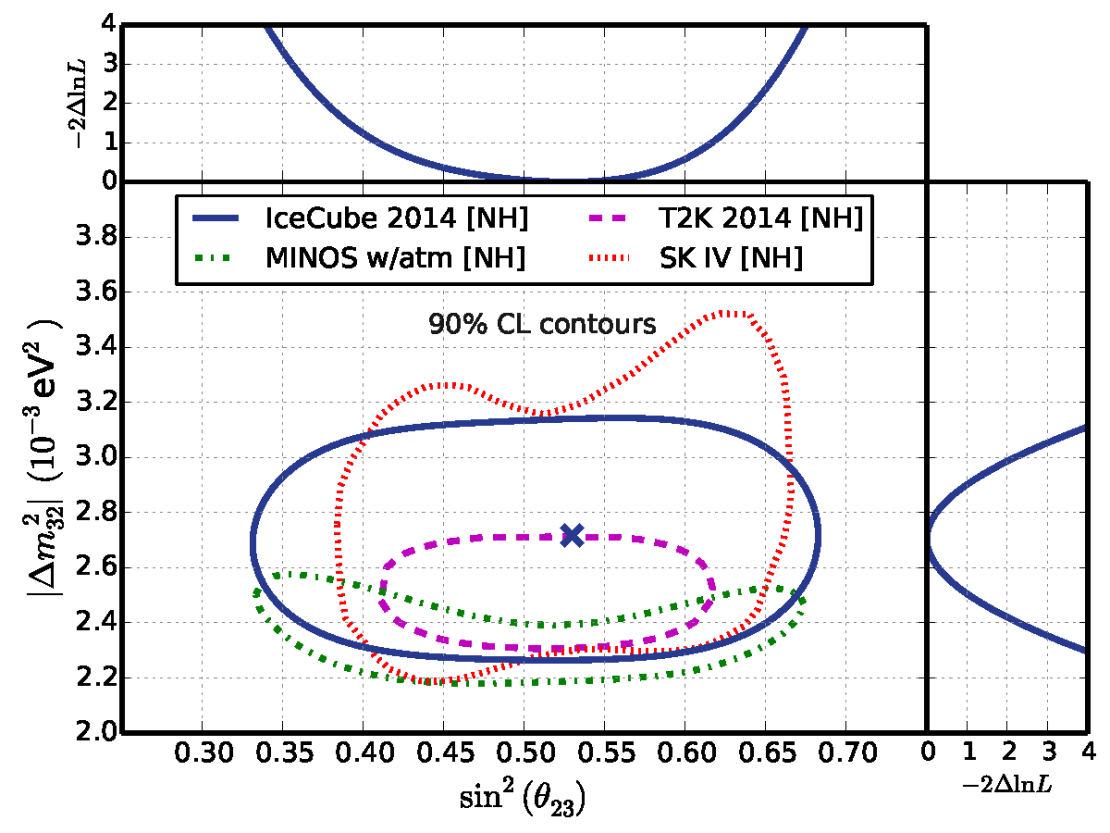The IceCube Neutrino Observatory at the South Pole continues to contribute new ways to tackle some of the big questions in astrophysics and neutrino physics research. Results on extraterrestrial neutrinos, cosmic-ray anisotropy, dark matter searches and now neutrino oscillations have proven IceCube to be a powerful tool for exploring the unknown universe using high-energy particles produced in Nature.
Last year, an initial measurement of the neutrino oscillation parameters was a hint that IceCube could become an important detector for studying neutrino oscillations. Today, the IceCube Collaboration has submitted new results to Physical Review Letters that present an improved measurement of the oscillation parameters, via atmospheric muon neutrino disappearance, which is compatible and comparable in precision to those of dedicated oscillation experiments such as MINOS, T2K or Super-Kamiokande.

Super-Kamiokande was the first experiment to claim the discovery of neutrino oscillations in 1998 from observing a deficit of atmospheric muon neutrino interactions in its detector.
In contrast to the man-made, water-filled vessel of Super-Kamiokande, IceCube uses a natural target material, the glacier ice at the South Pole. This has the advantage of a much larger observation volume and therefore a larger number of events at shorter time scales. A disadvantage is that the optical properties of ice are more complex. The corresponding uncertainties are taken into account in the systematical errors of the IceCube result.
“Today, both Super-Kamiokande and IceCube use the same “beam,” which is atmospheric neutrinos, but at different energies. And we reach a similar precision for the determination of the measurable oscillation parameters,” says Juan Pablo Yanez, a postdoctoral researcher at DESY and corresponding author of this paper. “But as IceCube keeps taking data and we keep improving our analyses, we might see important improvements in our collaboration results soon,” adds Yanez.
IceCube records over one hundred thousand atmospheric neutrinos every year, most of them muon neutrinos produced by the interaction of cosmic rays with the atmosphere. DeepCore, a subdetector of the Antarctic neutrino observatory, allows the detection of neutrinos with energies down to 10 GeV.
According to our understanding of neutrino oscillations, in which neutrinos can change their type on their trip through matter and space, IceCube should see fewer muon neutrinos at energies around 25 GeV and that reach IceCube after crossing the entire Earth. The reason for these missing muon neutrinos is that many oscillate into other flavors that are not seen by the detector or not selected in this analysis.
IceCube researchers selected muon neutrino candidates with energies between a few GeV and around 50 GeV and coming from the Northern Hemisphere from data taken between May 2011 and April 2014. About 5,200 events were found, much below the 7,000 expected in the non-oscillations scenario.
The parameters that best describe the IceCube data,
$$\Delta m^{2}_{32} = 2.72^{+0.19}_{-0.20}$$
and
$$\sin^{2} \theta_{23} = 0.53^{+0.09}_{-0.12}$$
(normal mass hierarchy assumed), show uncertainties still larger than but already comparable to the neutrino-accelerator experiments. Stay tuned for further news about neutrino oscillations in IceCube!
Info “Determining neutrino oscillation parameters from atmospheric muon neutrino disappearance with three years of IceCube DeepCore data,” IceCube Collaboration: M.G. Aartsen et al. Physical Review D91 (2015) 7, journals.aps.org arXiv.org:1410.7227